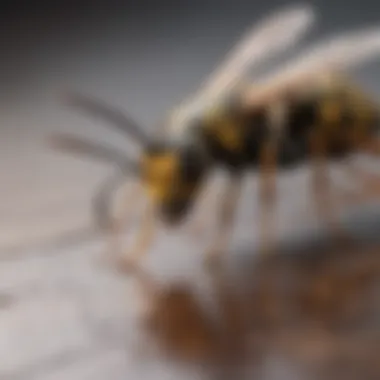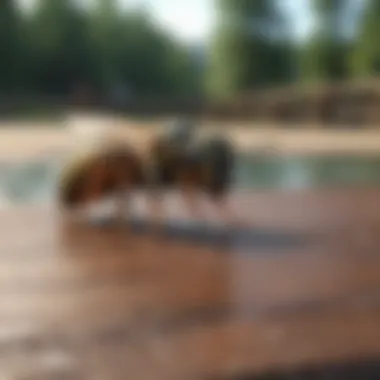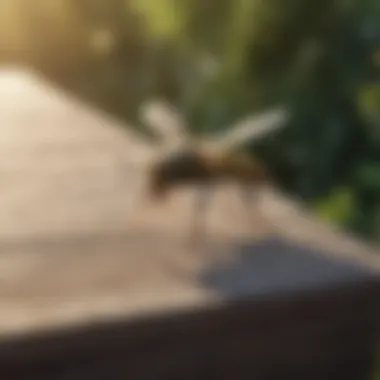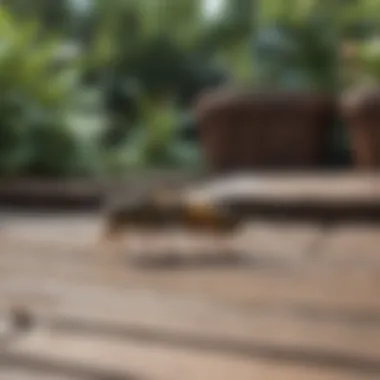Effective Strategies to Keep Wasps Away from Decks


Intro
Wasps are often seen as invasive pests, particularly during the warmer months. Their presence can make outdoor spaces, such as decks, less enjoyable. Understanding what keeps these insects at bay is vital for maintaining a peaceful environment. This article aims to provide practical methods to deter wasps from one’s deck. By examining the biological characteristics of wasps and various methods, both natural and chemical, readers will find effective strategies to keep their spaces wasp-free.
Fascinating Facts About the Animal
Unique Characteristics
Wasps belong to the order Hymenoptera, which also includes bees and ants. They are distinguished by their slender bodies and elongated waists. Wasps can be solitary or social. Social wasps, like yellowjackets and paper wasps, live in colonies and build nests that can be a nuisance in residential areas. Moreover, their color patterns can range from bright yellow to more muted tones, allowing them to blend into their surroundings.
Extraordinary Abilities
Wasps possess incredible abilities that aid in their survival. For instance, many wasps are skilled hunters. They catch and paralyze their prey, which can include other insects. This skill also plays a substantial role in natural pest control. Another fascinating ability is their keen sense of smell. Wasps can detect food sources from a significant distance, which explains why they are often attracted to outdoor gatherings.
Behavior and Habitat
Natural Habitats
Wasps thrive in diverse environments. They commonly build nests in trees, shrubs, or manmade structures. Wooden decks can provide excellent nesting sites due to their elevated positions and shelter from predators. Understanding their preferred habitats can aid in planning effective deterrent strategies.
Social Structures
In social species, the colony structure is highly sophisticated. Each wasp has a role, such as the queen, workers, and drones. This social organization allows colonies to work efficiently during the summer months. However, in the fall, colonies begin to die off, leading to increased wasp activity as they search for food sources. This is particularly relevant to decks, where food scraps or sweet beverages can attract them.
Recent Scientific Discoveries
Latest Research Findings
Recent studies have shed light on wasp behavior and their ecological roles. It is evident that wasps play a significant part in pollination and pest control in gardens. This knowledge can shift perspectives on their presence in outdoor spaces. Understanding that not all wasps pose a threat may help individuals manage their attitudes toward these insects.
Breakthroughs in Animal Biology
Innovations in insect biology have led to discoveries related to wasp communication. They use chemicals and pheromones to convey information about food sources and potential threats. This information is crucial for developing effective deterrents that disrupt these communication channels, minimizing wasp attraction to decks.
Cultural Significance
Animals in Folklore
Wasps have also found roles in various cultural narratives. Traditionally viewed as symbols of anger or hostility, certain societies depict them as protectors or messengers. Understanding these cultural perceptions can deepen the appreciation for these complex insects.
Influence on Art and Literature
Wasps have influenced art and literature, often symbolizing tenacity. Their depiction in artworks can evoke a range of emotions. Exploring these representations can open a dialogue about our relationship with wasps and their ecological significance.
"Understanding the balance of nature is crucial when managing wasp populations around our living areas."
Understanding Wasps and Their Behavior
Understanding wasps and their behavior is essential for effectively reducing their presence around decks. This knowledge enables property owners to anticipate wasp activity and implement informed strategies for deterrence. By comprehending the environmental preferences, habits, and nesting tendencies of wasps, one can create an outdoor space that is less inviting to these insects.
Insights drawn from understanding wasps lead to practical interventions. Instead of merely reacting to them, homeowners can actively discourage their presence through preventive measures. Furthermore, familiarity with their social structures and life cycles allows for better timing in application of deterents.


Wasp Species Commonly Found Around Homes
Wasps can be divided into two main categories: social wasps and solitary wasps. Social species like yellow jackets and paper wasps are common around human habitats. Yellow jackets are particularly notorious for their aggressive behavior. They often nest in the ground or in wall voids, seeking out food sources near picnics and trash cans. Paper wasps, on the other hand, build open-honeycomb nests under eaves and overhangs.
Solitary wasps, such as the mud dauber, do not exhibit aggressive behavior like their social counterparts. They may still be noticed near gardens as they hunt for spiders. Understanding these species helps in identifying the type of wasp problem one may deal with.
Life Cycle of Wasps
The life cycle of a wasp generally consists of four stages: egg, larva, pupa, and adult. Female wasps emerge in spring after hibernation and begin establishing nests. They lay eggs, which hatch into larvae that are fed by the adult wasps. After some time, the larvae pupate and eventually emerge as adults. The entire cycle can take several weeks, influenced by the species and environmental conditions.
Knowing the life cycle is critical. For instance, targeting nests early in the season may help prevent larger infestations later. Understanding these phases also clarifies when to observe increased activity around decks, enabling better management strategies.
Factors Attracting Wasps to Decks
Several factors can draw wasps to outdoor spaces. One primary attraction is food sources. Wasps are often lured to sweet substances like fruit, juice, or sugary drinks. Additionally, leftover food on tables or in trash bins provides an open buffet. Furthermore, wasps may also be attracted to protein sources such as meat scraps during summer barbecues.
Another significant factor is nesting potential. Areas sheltered from wind and rain are attractive spots for wasps to build their nests. Poorly maintained decks that provide crevices or sheltered areas can inadvertently encourage nesting. Eliminating these attractants is vital in reducing wasp visits around decks. Addressing the issues of food storage and proper waste management can create a less hospitable environment for these insects.
“By understanding the behavior and attraction factors of wasps, one can implement a comprehensive strategy to maintain a wasp-free deck.”
Natural Deterrents for Wasps
Natural deterrents serve as a primary line of defense against wasps. They are particularly significant because they limit the potential chemical exposure to people and pets while still providing efficacy in repelling these insects from outdoor spaces such as decks. This article prioritizes non-toxic methods that promote a safer environment. By using natural solutions, one can create a less attractive habitat for wasps while maintaining an inviting atmosphere for human enjoyment. Furthermore, these strategies often complement each other, enhancing overall effectiveness. Individuals who adopt these measures contribute to a healthier ecosystem.
Essential Oils and Their Efficacy
Essential oils have gained attention for their potential to repel wasps through scent. Crating a barrier using these oils can protect deck areas from unwanted invasions. They are particularly compelling because they are easy to use and can be sourced naturally. The following three oils are especially notable for their effectiveness.
Peppermint Oil
Peppermint oil stands out as a natural repellent due to its strong, intense aroma. Wasps generally dislike minty scents, making it a practical choice in their deterrence. This oil acts as both a preventive measure and a deterrent. When applied around deck areas, it creates an environment that is likely to keep wasps at bay. Moreover, peppermint oil is widely regarded as safe around humans and pets, thus enhancing its appeal in residential settings. However, it may require frequent reapplication, especially after rainfall.
Lemon Eucalyptus Oil
Lemon eucalyptus oil offers a unique citrus scent that can effectively deter wasps. Its key characteristic is the presence of citronella, which is known for its insect-repelling properties. This oil not only keeps wasps away but also adds a pleasant fragrance to the surrounding area. Its long-lasting efficacy when compared to other oils can make it a favorable option for homeowners. However, one must ensure proper dilution to avoid skin irritation.
Lavender Oil
Lavender oil is well-known for its calming properties, but it also serves as a wasp repellent. Its floral scent effectively helps in keeping these pests at bay. The soothing aroma may contribute to a relaxing outdoor atmosphere, making it a dual-purpose solution for home gardens. While generally safe, its effectiveness may vary depending on the concentration used. Regular application might be necessary to maintain its deterrent effect.
Plant-Based Solutions
Plants that naturally repel wasps offer another organic strategy for keeping decks clear of these insects. Landscaping with specific plants not only beautifies the space but also serves a practical function.
Plants that Repel Wasps
Certain plants, such as mint, basil, and marigolds, are known for their wasp-repelling properties. These plants release oils that create a hostile environment for wasps. Mint is particularly effective due to its strong scent; planting it near deck edges can create a natural barrier. Additionally, marigolds emit a pungent fragrance that deters not only wasps but also other pests, making them an advantageous choice for garden aesthetics and pest control.
Garden Layout Considerations
The arrangement of plants can significantly influence their effectiveness in repelling wasps. By grouping repellent plants together and providing adequate spacing, one can maximize their impact around a deck. It is vital to position these plants near food preparation areas or open space where people gather. This not only improves visual appeal but also minimizes potential conflicts with wasps, making outdoor activities more enjoyable. However, careful management of garden aesthetics is crucial to harmonize both utility and beauty.
Repellent Recipes for Home Use


Homemade repellents provide a practical solution for individuals looking to take control of their outdoor spaces. Simple recipes combining natural ingredients can effectively deter wasps without resorting to harsh chemicals. That said, those who choose to employ such solutions should remember to test any new blend on a small area of the skin to prevent potential allergic reactions.
Chemical Solutions and Their Considerations
Chemical deterrents offer a pragmatic solution in the control of wasps around decks. These solutions serve to reduce the attractiveness of outdoor spaces or directly repel these insects. Employing chemical strategies can prove beneficial, especially in scenarios where natural deterrents do not suffice or in cases of significant infestations. However, understanding the pros and cons is crucial for any homeowner or professional dealing with these pests.
Commercial Wasp Deterrents
Numerous commercial products are designed specifically for wasp deterrence. These include sprays, traps, and granules that can be deployed around deck areas. Popular options often contain pyrethroids, which effectively incapacitate wasps upon contact.
Several products stand out in the marketplace, such as:
- Hot Shot Wasp and Hornet Killer: Known for its immediate effect, it allows users to maintain a safe distance during application.
- Raid Wasp and Hornet Killer: This effective solution boasts a long-range spray, making it usable even from a distance.
- Terro Wasp and Hornet Killer: This product is appreciated for its fast action, helping in quick infestations.
When opting for commercial solutions, careful application according to the manufacturer's guidelines is essential. Misapplication can lead to ineffectiveness or unintentional harm to non-target species.
Safety and Environmental Impact
While chemical solutions can be effective, safety and environmental impact are key considerations. Many commercial pesticides are designed to target specific insects, minimizing effects on beneficial pollinators like bees. However, it is essential to evaluate their non-target effects.
Some points to consider include:
- Residue: Chemicals can leave unwanted residues on surfaces, potentially compromising health.
- Impact on Wildlife: Birds and other non-target wildlife could be affected unintentionally. Proper timing of applications can help mitigate this risk.
- Human Safety: Many pesticides require protective gear during application to prevent skin or respiratory exposure.
Being aware of these factors aids in striking a balance between effective wasp control and ecological integrity.
Best Practices for Application
To maximize effectiveness while minimizing risks, certain best practices should be observed when applying chemical deterrents. These include:
- Identify the Source: Before applying any solution, locate the primary nesting areas. This knowledge will ensure targeted applications and minimize wastage.
- Timing: Apply treatments during the early morning or late evening when wasps are less active. This reduces unforeseen encounters and enhances effectiveness.
- Follow Instructions: Each product comes with specific application recommendations. Adhering to these guidelines leads to better results and maintains safety standards.
- Evaluate Efficacy: Monitor the area after application. If wasps persist, it may be necessary to reassess the product used or the method of application.
Understanding the realm of chemical solutions allows for informed decisions when managing wasp issues. By weighing the options carefully, one can maintain an outdoor space that is enjoyable while effectively managing wasp presence.
Preventive Measures to Keep Wasps Away
Preventive measures are crucial for maintaining a wasp-free deck. Once wasps establish a presence, they can be difficult to remove, leading to potential safety hazards. By implementing effective strategies, homeowners can significantly reduce the likelihood of wasps invading their outdoor spaces.
Maintaining a Clean Deck Area
Proper Food Storage
Proper food storage is vital in keeping wasps at bay. Wasps are attracted to food that is easily accessible. By storing food in sealed containers, you remove any sources of attraction. This basic practice serves as a barrier against wasps and minimizes the risk of encountering them.
The key characteristic of effective food storage is its simplicity. Utilizing airtight containers ensures that food odors do not escape, which can otherwise lure wasps to your deck. This strategy is beneficial because it not only prevents wasp attraction but also keeps your food fresher for longer.
A unique feature of proper food storage is its cost-effectiveness. Most homeowners already own basic storage items. There are few disadvantages; however, if storage solutions are neglected, it can still create openings for wasps.
Regular Waste Management
Regular waste management is another essential aspect of wasp prevention. When trash accumulates, it often attracts wasps looking for food sources. Regularly emptying trash bins and cleaning up food scraps contributes greatly to keeping wasps away.
The key characteristic of efficient waste management is diligence. A consistent schedule helps in reducing the chance of wasps finding anything appetizing. This method is advantageous because it encompasses various aspects, such as securing trash bags and using bins with tight-fitting lids.


An important unique feature of waste management is its role in the overall cleanliness of the deck area. Failure to maintain proper waste disposal can lead to unsightly conditions, which may not only attract wasps but also create an unpleasant environment for guests.
Sealing Potential Nesting Spots
Sealing potential nesting spots on and around your deck is a proactive approach to minimize wasp infestations. Inspect your surroundings for any cracks or crevices where wasps may build nests. These areas could include eaves, under decks, and between railing boards. By sealing these parts, you create barriers that are challenging for wasps to penetrate, effectively reducing their likelihood of nesting in those areas.
Regular maintenance should include an inspection of all outdoor equipment and furniture for signs of wasp nests. Early detection allows for timely intervention, preventing further establishment. Small maintenance tasks go a long way in ensuring that your outdoor space remains clear of wasps.
Deck Furniture Considerations
The choice of deck furniture can influence wasp activity. Smooth surfaces without crevices are generally less favorable to wasps for nesting. For instance, opting for plastic or metal furniture over wood can reduce potential nesting spots. Additionally, consider storing any cushions and fabrics when not in use. Wasps may be attracted to soft materials for nesting.
Choosing attractive designs in materials can reduce the appeal for wasps while being visually appealing for guests. Maintain furniture regularly, clearing away any debris or spills that might invite wasps.
Ultimately, preventive measures require consistent effort. Attention to cleanliness and regular maintenance decreases the chances of wasps discovering your deck as a desirable location. By adopting these methods, homeowners can enjoy their outdoor spaces with minimized risk.
Behavioral Adjustments Around Wasps
When it comes to keeping wasps away from decks, understanding their behavior is crucial. Adjusting our own behaviors can significantly minimize the chances of encounters. This section emphasizes the importance of behavioral strategies that can be employed by families and guests who frequent outdoor spaces.
Timing Outdoor Activities
Outdoor activities should be planned with awareness of wasp behavior. Typically, wasps are most active during warm afternoons, especially in late summer and early autumn. During these times, they may appear more aggressive and territorial. Scheduling gatherings or meals at cooler times of the day, such as mornings or late evenings, can reduce interactions with wasps. Additionally, avoid areas where food is abundant, as these attract wasps.
To further minimize risks:
- Observe Weather Patterns: Wasps often seek food as the seasons change. If a cold snap approaches, they may become more aggressive in search of warmth and food.
- Keep Wild or Open Food to Minimum: If you are having lunch outside, try to keep food covered until ready to eat.
Understanding Wasp Aggression
Wasp aggression can often be misunderstood. Unlike bees, which generally do not sting unless threatened, wasps may pursue perceived threats. This means that sudden movements or frantic waving can provoke wasps. Understanding this can help in managing your reactions. Tranquility is key when encountering wasps. If a wasp comes close, remain calm, avoid swatting at it, and slowly move away.
Some specific points to consider include:
- Avoiding Bright Colors: Wear neutral or muted colors. Bright patterns may attract wasps.
- Minimizing Fragrance Use: Strong scents from perfumes or lotions can lure wasps closer.
Educating Family and Guests
Education is an empowering tool in managing wasp interactions. Families and guests should be informed about wasp behavior and the strategies to minimize risks. Informing everyone about the importance of remaining calm when facing wasps can help maintain a serene environment. It is also vital to educate children about how to behave around wasps. Simple instructions and reminders can prevent unnecessary panic.
Encouraging awareness can include:
- Discussing Safety Protocols: Ensure everyone knows what to do if they see a wasp.
- Providing Visuals: Show images of common wasp species, so they can identify them if they see one.
Wasp behavior often changes based on environmental factors. Understanding these changes can help you effectively manage outdoor experiences.
By implementing these behavioral adjustments, families can create a safer, more enjoyable outdoor space, reducing the chances of unwanted wasp encounters.
Culmination: Comprehensive Strategy for Wasp Management
The management of wasps, particularly as it relates to maintaining a pleasant outdoor space, cannot be understated. Understanding the behaviors and triggers that attract these insects is crucial for developing a comprehensive strategy. This involves a combination of natural deterrents, chemical solutions, preventive measures, and behavioral adjustments.
A multi-faceted approach provides several benefits. First, by employing both natural and chemical deterrents, one can create a balanced environment that discourages wasps without causing harm to beneficial insects. For instance, essential oils like peppermint and lemon eucalyptus can be effective yet safe alternatives. Additionally, maintaining cleanliness on decks through proper food storage and waste management reduces the attraction for wasps significantly.
Consideration of structural elements, such as sealing potential nesting spots, enhances the overall effectiveness of any strategy. Well-planned outdoor activities during times when wasp aggression is low can also mitigate unwanted encounters. Educating family members and guests about safe practices further strengthens the management efforts.
Effective wasp management blends knowledge of behavior with actionable strategies, ensuring a harmonious outdoor experience.
By adopting these insights, anyone can enjoy their outdoor spaces free from the disturbances caused by wasps. Whether one leans towards natural, chemical, or behavioral methods, the ultimate goal is to create an environment where wasps are less likely to become an issue.







